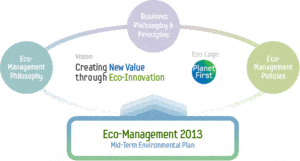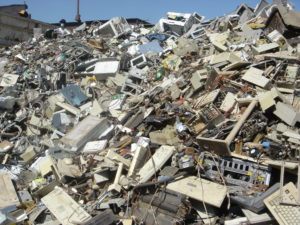Samsung Electronics : Green & Eco Management

Thoughts on the way how Samsung is navigating through the challenges and opportunities by Green and Eco Management
I. Climate change : Inevitable road.
What if our grandchildren take the “Yellow sky” more granted than the “Blue sky”? What if we have to see 1/3 of lands and ½ countries in the earth disappear while we are living? It is not an Hollywood movie, but a real possibility.
The climate change is totally changing the economy rule of the world already. The global market for alternative energy sources, i.e, wind, solar energy and bio fuels, will reach $315 billion by 2018. [1] To cope with the economic effect, and huge possibilities for making or saving the money, most of the countries and large cap companies are counteracting extremely fast. For example, the proportion of the China’s greenhouse gas emissions has changed, mainly due to a combination of energy reforms, economic restructuring, forestry policies. [2]
II. Threats and Opportunities from the climate change.
As we are aware of, the climate change can pose a significant threat to the world economy. A growing number of studies are showing that it could be disastrous for the bottom lines of companies around the world. [3] This will not only deteriorate the bottom line of the businesses, but also will pose huge threats to the investors. All the regulations and governmental risk can stifle the innovation from the state-of-the-art huge manufacturing complexes and drive the world economy to the low-carbon environment.
However, there also exists the opportunities tied up to upper mentioned threats. Companies can realize the concern over regulatory risk and governments proactively managing the transition to a low-carbon economy is one that they need to take into account while planning their business strategies. That is why the private sector has become increasingly more open to a price on carbon and is calling for more stable regulatory regimes and long term price signals. [4]
III. Case study: Samsung Electronics – “SMART- Green Management” : Navigating through threats and opportunities
Samsung Electronics, the world’s largest high-technology company in terms of the revenue, is also transforming itself to adjust to the rapid change in the climate, and perform its social responsibilities for consumers and global citizens.
1. 5 Key concepts of SMART Green Management Strategy
Samsung has taken its initiative further to introduce SMART Green Management efforts in meeting the growing demand of the era for balanced development of the economy, environment and society. The SMART Green Management strategy consists of the following five concepts:
- Sustainability: execute green management as core strategy for sustainable management
- Market: explore new markets by solving environmental problems
- Advantage: seek additional advantage of creating profit through environmental conservation
- Restructuring: conduct business restructuring to be more focused on environmentally friendly strategy
- Transparency: strengthen transparency to better communicate and cooperate with society
2. Mid term roadmap for Action Items (by 2020)
Based on the the Samsung’s internal research, it concluded there are two major areas from which it can make significant contribution to the reduction of the green house gas emission.
The first area is to bring reduction at the Product Use Stage, which means the time when consumers are using the electronic devices. (Cumulative Reduction of 250 Million Tons from 2009 to 2015) In order to reduce green house gas emissions at the product use stage, Samsung continuously tries to improve the energy efficiency of products, with the aim of achieving a cumulative reduction of 250 million tons of green house gas emissions at the product use stage from 2009 to 2020.
The second area is to bring reduction of the emission Intensity at worksite, and the target is to reduce 70% of Intensity by 2020 Compared to 2008. To reduce green house gas emissions at manufacturing sites, Samsung operates facilities with high energy efficiency and treats gases generated during the production process such as F-Gas. By doing this, Samsung aims to reduce 70 percent of 2008 green house gas emission intensity levels by 2020. green house gas emissions intensity has increased due to the expansion of our global manufacturing sites and production facilities, but we will work hard to reduce absolute emissions by continuously improving energy efficiency at each worksite.[5]
3. Take initiative: work on more “E-waste”
Even though Samsung did a great job so far, it still has an area to work on more. It is E-waste. Tons of E-waste, including old TV, PC, smartphones, are discarded by households and stacked up at China and India.
The only way to remove those E-waste is to burn, however, when those are burn it would hamper the climate. Though it is beyond direct responsibilities of the electronics companies, Samsung should lead the initiative to remove and process E-waste by building alliance with other manufacturer.
[1] MIT Sloan Management Review
[2] Science Magazine
[3] World Bank report
[4] Samsung official website
[5] Samsung company blog







Thanks Christian. I think investing in more sustainable manufacturing practices and developing more energy-efficient devices makes a ton of sense. My main concern here is your last point on waste/disposed products. Is there an ongoing attempt to close the loop by allowing customers to return their widgets and centralize a recycling process for them right now?
Yes, Haibo there is initial initiative to address this serious problem which caused environmental problems in China and India. Happy to chat on this any time.
Great article Christian! While I agree with Haibo that it is necessary to make devices more energy-efficient, I doubt that there is a great impact of it, due to two reasons.
First, the majority of Samsung products are end-consumer devices which get more sophisticated. With each additional feature they require more energy. Considering smartphones for example: Vendors develop better batteries with every generation, but the actual battery life does not increase. Every phone needs to get charged every day. Both, battery improvements and additional features have a limit so the changes will be less substantial in future. However, I think the battery life itself and thereby the charging frequency won’t change.
Second, consumers use more and more different devices and spend more time with them. As addition to smartphones, PCs, etc. many people use wearables and other connected gadgets that require energy.
Thanks for the posting, Christian. It’s interesting learning about the initiatives and steps Samsung has put into place to try and cut down on emissions and drive other efficiencies. I’m a bit surprised that they would focus on the energy intensity, rather than the actual consumption rate. Are they taking measures in this direction concurrently with their intensity efforts? The second part I find interesting is that they were looking at the e-waste side. I wonder if they could pursue something like what Ikea is doing in terms of recycling and reusing parts in the same way. It seems like there would be a lot of opportunity on this side that they could also pursue as it will also address some of the upfront consumption parts as well.